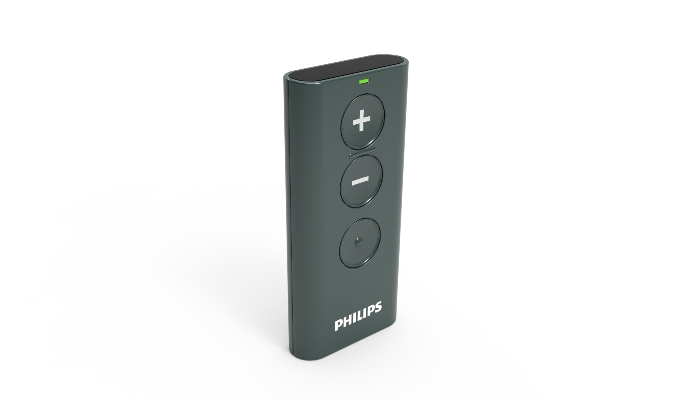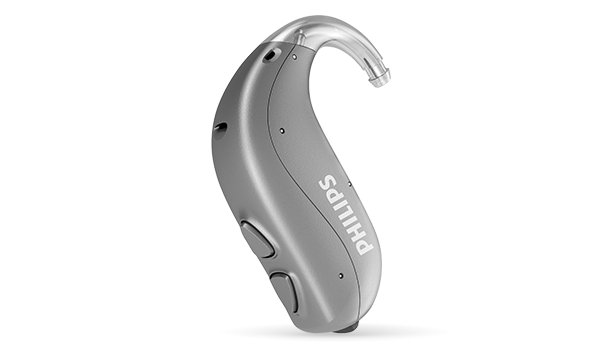The Philips HearLink 2010 BTE PP in review
Diese Technik ist nicht mehr ganz aktuell. Wir haben daher eine Abwertung der Gesamtnote vorgenommen. Nutzen Sie unseren Hörgerätevergleich für einen Überblick über die neuesten Techniken.
Philips is launching its HearLink 2010 BTE PP, a conventional hearing aid in a solid mid-price range. It is a small hearing aid for mild, moderate, and severe hearing needs and is worn behind the ear.
Hearing comfort
Hearing aids are meant not only to bring speech to the ear but also to sound pleasant. So let's first look at the comfort features. What types of noise does the hearing aid recognize? Are they dampened or transmitted unchanged? Is the hearing aid suitable for a lively everyday life? Here with this test device, we find only the absolute necessities when it comes to hearing comfort. As in every hearing aid, typical noise reduction is included here. It is supposed to reduce uniform, noisy background sounds to the point where they no longer dominate. With the HearLink 2010 BTE PP, this works only to a limited extent. There’s nothing more than very basic noise suppression here.
We have found a basic wind detection, but unfortunately, nothing is adjustable. Points are deducted for the lack of impulse noise suppression. Normally, this dampens short, clattering noises. But those who choose this hearing aid should not be bothered by that. Let’s take a quick look at the equalizer: With 8 bands, it is not particularly flexible. With a few more channels, we would certainly have achieved a nicer, more natural sound experience. But at least we can reasonably adjust the sound to our hearing preferences. We are far from a 3D sound experience here. Only the switchable focus forward offers a bit of hearing support in social situations.
Sometimes we encounter hearing aids that successfully process data using artificial intelligence, but this device is not yet one of them.
Rating Hearing comfort: 5,0

Philips HearLink 2010 BTE PP: Steps in the snow are uncomfortably loud for some hearing aid users. This can have various causes. In any case, it is related to sound acclimatization. When there is hearing loss, the environment becomes quieter. With hearing technology in the ear, everything is louder at first. During the acclimatization phase, a person learns to hear and categorize sounds anew and perhaps to compare them with their hearing memory. Hearing memory means that the hearing aid user remembers the sound "steps in the snow" differently than how they hear it now with the hearing aids. This gives the question "what sounds normal now?" a new meaning.
Operation & connectivity
Most hearing aids automatically adapt to their environment. However, it is sometimes very practical to be able to make adjustments yourself. After all, the hearing aid doesn’t know how you are feeling at the moment. We looked at the control options offered by the HearLink 2010 BTE PP: A very quick way to adjust the volume is the small button on the device. It is easy to feel, and you can increase or decrease the volume in several steps. Additional programs for specific hearing situations can also be activated this way. If you wish to forgo the button, it can simply be deactivated. If desired, there is a remote control for the hearing aid. This allows for effortless volume adjustment. The handling is not only child’s play, but no one will notice that you are adjusting your hearing aids.
Voice commands are a fairly new way to operate hearing aids. However, in this model, we do not have this feature yet. That is not a big deal - the main thing is that you can hear well. If there are sensors in the hearing aid, a tap control could be conceivable, which would trigger a specific function by tapping your fingers on your ear. However, this option is not available in the HearLink 2010 BTE PP.
The manual control includes an app. This allows you to access the hearing aid discreetly. In addition to volume control, you can also adjust hearing programs and a few other functions. We really enjoyed the direct, wireless streaming. This means that calls from the smartphone are transmitted to the hearing aids without any additional accessories. This turns the hearing aid into the perfect hands-free system or wireless headphones. Listening to music or watching and hearing videos is incredibly comfortable.
Rating Operation & connectivity: 2,0

Philips HearLink 2010 BTE PP:
The best alternatives to the HearLink 2010 BTE PP
Our database contains 84 reviews of hearing aids with similar technical features to this one (i.e., in a classic form in Size "S - small", not rechargable, Suitable for Degree of Hearing Loss Mild, moderate & severe). Here are the top 3 (Review: November 2025):

|
Hansaton Beat FS 9 R T 13 | Rating: 5 / 5 |

|
Hansaton Beat FS 9 R T 312 | Rating: 5 / 5 |

|
Philips HearLink 9040 MNB T | Rating: 4.5 / 5 |
Simplicity & security
Another point on our checklist is handling. Does everything work simply and reliably? What does the hearing aid offer to ensure safe use in everyday life? When it comes to simplicity in hearing, we don't make compromises. We expect the hearing aid to function fully automatically in the background and not require us to constantly press any buttons. With the HearLink 2010 BTE PP, we are somewhat disappointed. Only basic situations are automatically recognized. This means that we cannot really cope without manual operating options. We are very pleased with the integrated acclimatization manager. It gradually raises the volume of the hearing aid in tiny steps until our target amplification is eventually reached. We can relax and gradually get used to the new listening experiences.
The HearLink 2010 BTE PP is not equipped with a battery, so it is not rechargeable. It uses a hearing aid battery size 13 as its power source. It needs to be replaced every few days.
We had a carefree everyday life in our test due to the IP-68 certification. This means that the hearing aid is particularly well protected against dust and water. We marched through the rain and then took out the hearing aids with wet hands - no problem at all. However, the water resistance really only refers to fresh, natural water and not foamy bathwater or saltwater.
Rating Simplicity & security: 2,8
Extras
Finally, let's briefly check if there are any extras: A tinnitus program would be an additional perk. Many people suffering from their ear noise could benefit from this. Unfortunately, the HearLink 2010 BTE PP lacks a tinnitus option and loses a few points in the test.
Philips keeps up with the times and provides a future-oriented feature with the remote adjustment service. Busy professionals with little time can contact their audiologist online and have their hearing aids reprogrammed. Hearing aid users who have a longer travel distance to the specialist store also benefit from this special service.
If Philips had integrated motion sensors into this hearing aid, individual health tracking could even occur. However, that is not the case here. These points are lost for the HearLink 2010 BTE PP in the evaluation. In connection with a smartphone, the HearLink 2010 BTE PP surprises us with a few nice lifestyle features. It is definitely worth getting thoroughly familiar with the app and using the offered assistance programs.
Rating Extras: 2,5
Conclusion: Philips HearLink 2010 BTE PP
In the overall result, this test device ranks in the lower positions and lacks some features. We give it a score of 4.08. For less demanding listeners, this is acceptable, but for a very active lifestyle, we recommend a hearing aid with more extensive comfort features.
Top alternatives in the same price range
Which devices in a comparable price range currently show the best technical performance? Here are the current top 3:

|
Hansaton Beat FS 3 R T 13 | Rating: 4 / 5 |

|
Hansaton Beat FS 3 R T 312 | Rating: 4 / 5 |

|
Hansaton Beat FS 3 R T 675 | Rating: 4 / 5 |
Our Philips HearLink 2010 BTE PP review was created on May 25, 2023 . The overall rating of 4,08 is composed of: »Hearing Comfort (40% weighting): Rating 1 | »Operation & Connectivity (28% weighting): Rating 4 | »Simplicity & Security (17% weighting): Rating 3.5 | »Extras (15% weighting): Rating 3.5 | Learn more about our evaluation criteria and testing standards in How We Test..
FAQ
Is the HearLink 2010 BTE PP from Philips suitable for me?
The fitting range of this hearing aid is "hearing loss mild, moderate, or severe." Whether your hearing deficiency falls within this range can be quickly assessed by a local audiology specialist.
How much does the HearLink 2010 BTE PP from Philips cost?
The rough price range for the Philips HearLink 2010 BTE PP currently offered in Germany is approximately between €1,300.00 and €2,000.00. You should also take a look at the overall evaluation: the overall test score in the HörShop test is 4.1 (sufficient). Details are also important for contextualizing the hearing aid price: The star rating for "noise suppression" in the test shows only 1 out of 5 stars.
What size is the Philips HearLink 2010 BTE PP?
This behind-the-ear hearing aid has been classified into size class S. This means it is medium-sized. You can compare it with other hearing aids in this size class: Hearing aid comparison.
How well does one hear with the Philips HearLink 2010 BTE PP?
The HearLink 2010 BTE PP from the manufacturer Philips is equipped with 8 separately adjustable equalizer bands (for context: current top devices have 25 bands). The rating for noise suppression for this device only achieves 1 out of 5 stars. The quality rating 'moderate' (only 1 out of 5 stars) is given for the wind noise suppression of the HearLink 2010 BTE PP. Summarizing the entire area of "listening comfort," the overall score in the test is 5.0 (poor).
Compare hearing aids: discover all other current reviews now
Find and sort all currently listed hearing aids now. You have full access to all filters, allowing you to quickly view the top hearing aids at a glance.



